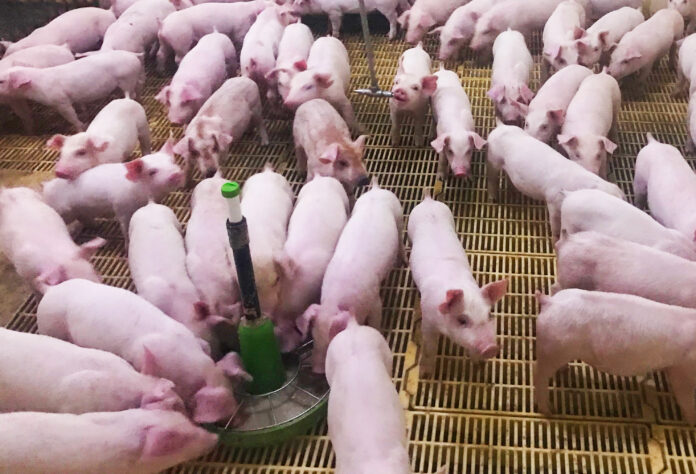By Cordell Young
Editor’s note: Cordell Young is a veterinarian with Precision Veterinary Services, based in Alberta. He can be contacted at cordell@precisionvet.ca.

When Fairlane Colony in Alberta – a 370-sow farrow-to-finish operation – noticed an unusually high number of sick pigs in its herd in 2020, alarm bells quickly sounded.
“We knew there was a problem right away, so we called our vet,” said Steven Waldner, Fairlane’s barn manager. “She came out to our farm to see what was happening and suggested we start dealing with it right away.”
Initially, Porcine Reproductive and Respiratory Syndrome (PRRS) appeared to be the culprit, which is bad news for any producer, given the amount of time and resources required to recover from such an outbreak. The farm immediately began to use medication to stem the spread of what was believed to be PRRS.
However, other options still remained on the table. After the outbreak was already underway, Waldner reached out to Precision Veterinary Services for additional support. Our initial thinking was, what if some kind of influenza, not PRRS, was responsible?
Unfortunately, at that time, the perspective on flu vaccines wasn’t particularly promising, but Waldner’s determination and Precision’s persistence remained steadfast. We knew a solution was needed – something that could reverse the farm’s fortunes and save its animals from further suffering.
Attacking the issue head-on

Early samples for flu strains came back negative, but further diagnostic analysis ended up determining the problem: H1N2, a subtype of Influenza A, which is sometimes called ‘bird flu’ but is endemic in pigs and can also infect humans. Its symptoms can be similar to PRRS, and co-infections of PRRS and H1N2 are not unheard of.
While the discovery was jolting, knowing what was behind the problem ignited a spark of hope. Armed with newfound knowledge, the team launched into action. The farm underwent internal biosecurity changes and an intensive process to initiate flu vaccinations – a critical step towards turning the tide against the illness that had plagued them for so long. The decision to implement vaccinations proved to be a game-changer.
“Vaccination really helped get our production back on track,” said Waldner. “All of the performance metrics got better, and we didn’t need to use as much medication anymore. After that, we were able to continue mostly as normal, with upgraded biosecurity.”
Fast-forward to 2023, and Fairlane’s numbers paint a compelling picture of resurgence, thanks to the effectiveness of the vaccine and the producer’s ability to do what needed to be done.
One of the most significant changes was the number of sows that farrowed early. Using 115 days of gestation as the cut-off, only half as many sows farrowed early post-vaccine compared to before. This matters because piglets born at that point in gestation are often considered premature, have higher rates of mortality and are poorer quality. This had a substantially positive impact on overall piglet viability by reducing the amount of labour and stress that might have been required during the first two days after farrowing and also reduced scouring outbreaks.
Adjusted farrowing rates increased to nearly 92 per cent, which was a dramatic improvement. The average gestation length of just over 116 days highlighted the farm’s change in sow stability, as piglets born alive per litter surged to 15.27, with the mummified fetus rate dropping to a mere 1.8 per cent, which suggests improved sow health and prenatal care. The average litter birth weight also increased modestly from 20.2 kilograms to nearly 20.7 kilograms, underscoring better nutrition and piglet development.
The average number of piglets weaned per litter increased from 12.17 to 12.92, with pre-weaning mortality decreasing to 14.5 per cent from 15.5 per cent, pointing to improved piglet health and care post-birth. Piglets weaned per sow per year also increased substantially from 29.62 to 31, which could be a combination of management efficiency and possible genetic improvements.
The breeding female cull rate also decreased to 41.9 per cent from 50 per cent, indicative of improved herd health and culling decisions. The average number of parities of those sows increased to 5.29 from 3.13, which tells us more of the young sows were able to withstand the demands of production without the additional challenge of H1N2.
Recovery continues, with the power of knowledge

Beyond the numbers, the recovery process taught us some valuable lessons, which helped Fairlane right its course in the aftermath, even leading to production benefits.
“We saw a very big improvement in weaning since getting the problem under control,” said Waldner. “The average birthweight per piglet is a bit lower than before, and we don’t quite know why, but it could be the higher number of births. In any case, this hasn’t hurt the piglets’ health or average daily gain on the sow. That part has actually been even better.”
While some residual coughing remains, even today, it’s a far cry from the previous state of the herd. While no flu vaccine is capable of completely removing all the long-term respiratory challenges that emerge, vaccines are a powerful tool for veterinarians to offer producers, and the results speak for themselves. Today, Fairlane’s herd looks much better than three years ago.
In addition to addressing the disease itself, Fairlane’s biosecurity has improved. Hallways used to move piglets from the nursery to the scale are now washed weekly, and new clothing protocols involve a change of coveralls, gloves and boots before moving between the grow-finish, nursery and farrowing rooms of the barn.
Fairlane Colony’s unwavering commitment to finding a solution in collaboration with veterinary support helped the farm battle through sickness and uncertainty to emerge victorious. The journey from a state of crisis to a better, healthier life for the farm’s pigs is a testament to the power of science, understanding disease, resilience and the importance of working as a team.
Fairlane’s experience showcases what can be achieved with the right tools, expertise and dedication to problem-solving. Even in the face of the most daunting challenges, there is always a way forward – a path towards triumph, growth and transformation.




